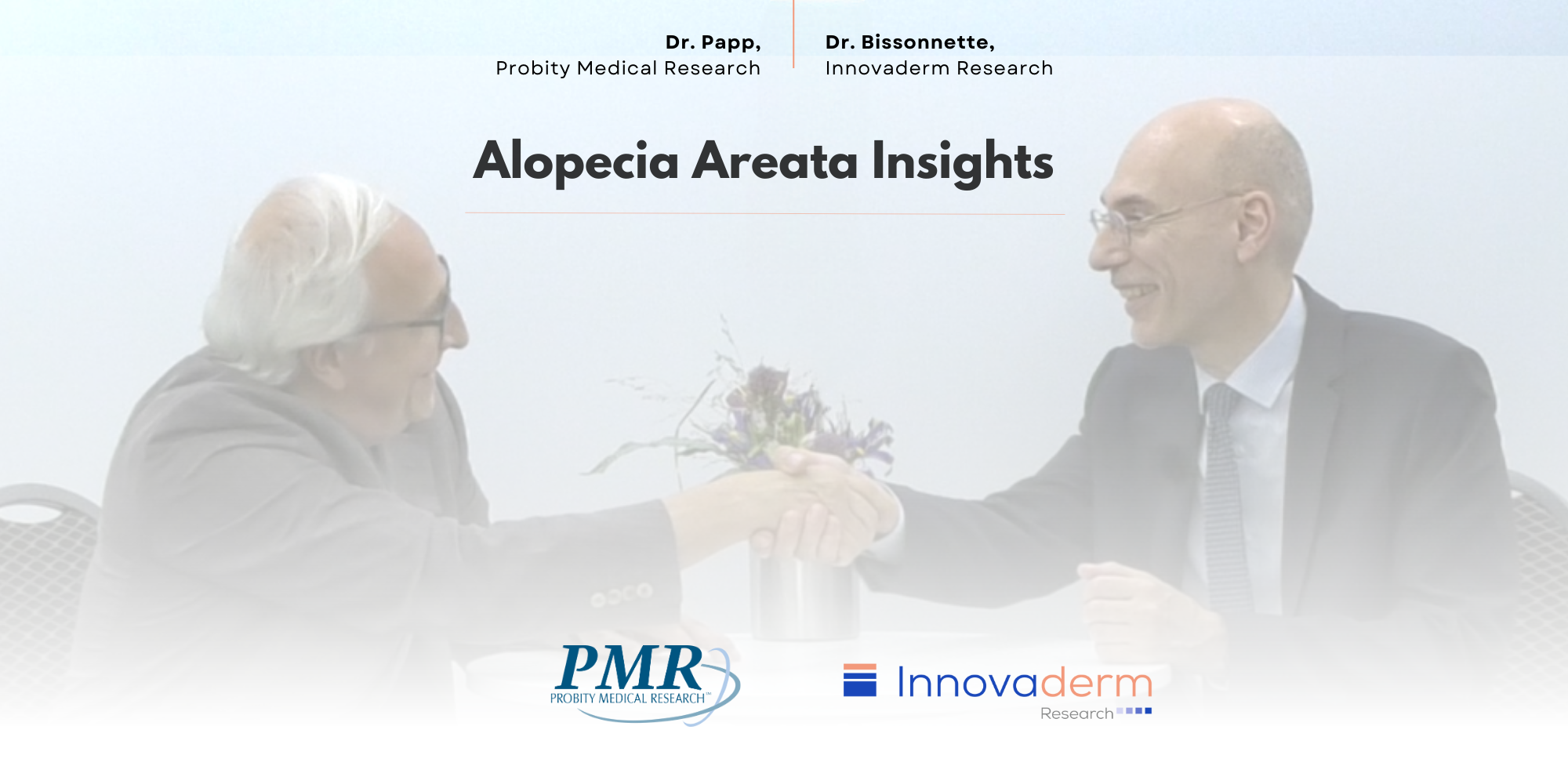Dr. Robert Bissonnette and Dr. Kim Papp on Alopecia Areata Insights

In collaboration with Probity Medical Research (PMR)
Dr. Robert Bissonnette from Innovaderm Research and Dr. Kim Papp from Probity Medical Research (PMR) met at the 2023 EADV for an engaging conversation focused on the intricacies of early phase studies and explored the significant challenges of conducting vitiligo studies. In this article, we shift the focus on alopecia areata (AA) studies insights, exploring the experiences of these seasoned dermatologists.
A Great Leap in AA Studies
Dr. Robert Bissonnette— There has been a surge in activity in the AA therapeutic area recently, particularly noteworthy for dermatologists. Just 5 to 10 years ago, our options for treating patients with AA were quite limited. I am keen to hear your perspective on the challenges associated with AA studies, both from a clinical research standpoint and from a site’s perspective.
AA Studies: Scoring, Retroactive Adjustments, and Treatment
Dr. Kim Papp— Certainly, I believe that AA studies encounter similar challenges to those we faced when examining vitiligo, particularly in terms of hair density. Another aspect we confront is the presence of confounding factors for individuals experiencing hormonal or genetically related hair loss. Determining the situation beforehand is challenging, and retrospective adjustments to the scoring system become necessary, given that it is only after the fact that we can gain clarity. It is crucial for us to develop a better understanding of how to implement retroactive adjustments, as starting with inaccurate assumptions can limit certain scores.
When considering regulatory perspectives, implementing such adjustments may pose challenges, but from a clinician’s standpoint, the current situation is promising. For the first time, we have a treatment that is reasonable, consistent, and yielding positive results. While persistence with the treatment remains an issue, the progress made in the last 5 years surpasses that of the preceding 5 decades. I am optimistic about further advancements in the near future, and I trust that you, Dr. Bissonnette, will exert every effort to contribute to this positive trajectory.
Fluctuating Inclusion Criteria
Dr. Robert Bissonnette— Recently, in the context of AA studies, I have observed a trend, distinct from what we encounter in atopic dermatitis (AD) and psoriasis. Some sponsors are modifying the inclusion criteria. Historically, we adhered to the Severity of Alopecia Tool (SALT) 50 to 100, but now we are seeing variations such as 50 to 99, 50 to 95, and discussions about potentially lowering it to SALT 25 or even further. This raises some concerns for me, particularly because patients in the lower SALT range tend to exhibit more fluctuation. This increased variability can lead to higher placebo responses, posing a greater challenge, especially for proof-of-concept (POC) studies, when drawing conclusive results.
Dr. Kim Papp— Certainly, it is a balancing act between swift recruitment, given the larger pool of patients with milder hair loss compared to those with more extensive loss. You are absolutely correct; the spontaneous regrowth at that level is highly variable. If asked for my opinion, I would advise against it, as lowering the criteria increases the likelihood of encountering noise in the data. While you might discern that the treatment works, the extent of its efficacy becomes obscured by the inherent variability, making it challenging to gauge its true effects accurately.
Study Design— The Importance of Seeking Experts’ Opinion
Dr. Robert Bissonnette— I completely agree. In my experience, some protocols often originate from sponsors with an in-house dermatologist who either works alone or consults with a single individual without seeking broader input. As a Contract Research Organization (CRO), there have been instances where sponsors provided us with a protocol, allowing only a 24-hour window for review, permitting minor changes, and disregarding any other suggestions. It is disheartening, especially considering they are collaborating with a dermatology specialized CRO, not to seek our input. In contrast, the most effective protocols typically involve sponsors engaging multiple individuals with diverse backgrounds, including those actively involved in patient care within clinical research.
Dr. Kim Papp— I am not as lenient in that aspect… While I do not necessarily advocate for a committee-designed approach, I do believe that the protocol should undergo scrutiny from individuals experienced in the field except that one does not need to be an expert in vitiligo, for example, to assess the feasibility and practicality of a protocol—both you and I can contribute valuable insights in that regard.
Dr. Robert Bissonnette— Nevertheless, I believe that the crucial factor is that if it undergoes evaluation by only one individual, the overall quality is likely to be compromised.
Dr. Robert Bissonnette— Even with our extensive experience in overseeing clinical research for over 25 years, there are always aspects that neither you nor I may have considered.
Dr. Kim Papp— I agree 100%. Entrusting the responsibility to a single individual can be restrictive, leading to limitations. Nevertheless, I remain cautious about adopting a committee approach on a large scale as it tends to dilute the process and introduces more noise than quality. Nevertheless, I support involving more than one individual, perhaps within a confined and experienced group, who can thoughtfully consider the drug and patient needs.
Dr. Robert Bissonnette— We both agree here!
In conclusion, the insightful conversation with Dr. Kim Papp and Dr. Robert Bissonnette sheds light on the complex landscape of AA studies. The pair showcased the importance of thoughtful protocol design, emphasizing the need for collaboration and expertise to address the unique situation of AA studies.
Follow the link to gain access to the full interview.
Let’s shape the future of research and make a difference in the industry, gain Innovaderm’s support in your upcoming trial and propel your study to new heights.
Additional resources on alopecia areata
🎙️ Interested in gaining more insights on AA? Tune into our podcast, Phase Forward, featuring Fadi Achkar, Innovaderm’s Project Director. Follow the link to listen.
Newsletter
Newsletter subscription resources

